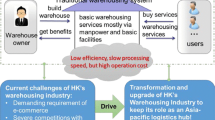Abstract
To obtain higher profits, a third-party overseas warehouse increases the delivery frequency of goods by setting a holding cost rate that increases with the holding time. To reduce the cost incurred from using the third-party overseas warehouse, small cross-border e-commerce retailers form a coalition to jointly replenish the overseas warehouse. Based on cooperative game theory, this paper designs a cost allocation rule to allocate the total cost of a cooperative coalition. The cost allocation rule is proved to be in the core of the corresponding cooperative game, indicating that it satisfies individual rationality and coalition rationality. An \((1+\epsilon )\)-approximate algorithm is presented to search for the optimal replenishment cycle under joint replenishment. Numerical experiments show that joint replenishment can help small cross-border e-commerce retailers to reduce costs, shorten replenishment cycles, and expedite commodity turnover. Having a greater number of retailers involved in joint replenishment would help to save more costs. The average saving cost rate after cooperation can be 58% when the fixed costs are very high.






Similar content being viewed by others
References
Agi MA, Soni HN (2019) Joint pricing and inventory decisions for perishable products with age-, stock-, and price-dependent demand rate, Journal of the Operational Research Society, 1–15
Ai XY, Zhang JL, Song DP et al (2019) Modelling and optimising the multi-item stochastic joint replenishment problem with uncertain lead-time and controllable major ordering cost. Eur J Ind Eng 13(6):746–774
Alfares HK, Ghaithan AM (2019) EOQ and EPQ production-inventory models with variable holding cost: state-of-the-art review. Arab J Sci Eng 44(3):1737–1755
Anily S, Haviv M (2007) The cost allocation problem for the first order interaction joint replenishment model. Oper Res 55(2):292–302
Arkin E, Joneja D, Roundy R (1989) Computational complexity of uncapacitated multi-echelon production planning problems. Oper Res Lett 8(2):61–66
Barron Y (2021) A Replenishment Inventory Model with a Stock Dependent Demand and Age Stock Dependent Cost Functions in a Random Environment. Asia Pacific J Oper Res 2021:2150035
Bastos LDSL, Mendes ML, Nunes DRDL, Melo ACS (2017) A systematic literature review on the joint replenishment problem solutions: 2006–2015. Production 27:e20162229
Boctor FF, Laporte G, Renaud J (2004) algorithms for the dynamic-demand joint replenishment problem. Int J Prod Res 42(13):2667–2678
Braglia M, Castellano D, Frosolini M (2016) Joint-replenishment problem under stochastic demands with backorders-lost sales mixtures, controllable lead times, and investment to reduce the major ordering cost. J Oper Res Soc 67(8):1108–1120
Braglia M, Castellano D, Gallo M (2016) An extension of the stochastic joint-replenishment problem under the class of cyclic policies. Oper Res Lett 44(2):278–284
Chen Y, Yang L, Jiang Y et al (2019) Joint replenishment decision considering shortages, partial demand substitution, and defective items. Comput Ind Eng 127:420–435
Chung CS, Hum SH, Kirca O (1996) The coordinated replenishment dynamic lot-sizing problem with quantity discounts. Eur J Oper Res 94(1):122–133
Cohen T, Yedidsion L (2018) The periodic joint replenishment problem is strongly np-hard. Math Oper Res 43(4):1269–1289
Cui L, Deng J, Liu R et al (2020) A stochastic multi-item replenishment and delivery problem with lead-time reduction initiatives and the solving methodologies. Appl Math Comput 374:125055
Cui L, Deng J, Zhang Y, Tang G, Xu M (2020) Hybrid differential artificial bee colony algorithm for multi-item replenishment-distribution problem with stochastic lead-time and demands. J Clean Prod 254:119873
Cui L, Deng J, Zhang YJ et al (2020) Hybrid differential artificial bee colony algorithm for multi-item replenishment-distribution problem with stochastic lead-time and demands. J Clean Prod 254:119873
Ding S, Kaminsky PM (2020) Centralized and decentralized warehouse logistics collaboration. Manuf Serv Oper Manag 22(4):812–831
Dror M, Hartman BC (2007) Shipment consolidation: who pays for it and how much. Manag Sci 53(1):78–87
Dror M, Hartman BC, Chang W (2012) The cost allocation issue in joint replenishment. Int J Prod Econ 135(1):242–254
Federgruen A, Wang M (2015) Inventory models with shelf-age and delay-dependent inventory costs. Oper Res 63(3):701–715
He S, Sethuraman J, Wang X, Zhang J (2017) A non-cooperative approach to cost allocation in joint replenishment. Oper Res 65(6):1562–1573
Hezarkhani B, Slikker M, Woensel TV (2018) Collaborative replenishment in the presence of intermediaries. Eur J Oper Res 266(1):135–146
Hoque MA (2006) An optimal solution technique for the joint replenishment problem with storage and transport capacities and budget constraints. Eur J Oper Res 175(2):1033–1042
Huh WT, Janakiraman G, Muharremoglu A, Sheopuri A (2011) Optimal policies for inventory systems with a generalized cost model. Oper Res 59(4):1040–1047
Jouida SB, Krichen S, Klibi W (2017) Coalition-formation problem for sourcing contract design in supply networks. Eur J Oper Res 257(2):539–558
Khouja AM, Goyal BS (2008) A review of the joint replenishment problem literature: 1989–2005. Eur J Oper Res 186(1):1–16
Krpeolu E, En A, Guler K (2012) Non-cooperative joint replenishment under asymmetric information. Soc Sci Electron Publ 227(3):434–443
Levi, R., Sviridenko, M., Improved approximation algorithm for the one-warehouse multi-retailer problem, Approximation, Randomization, and Combinatorial Optimization. Algorithms and Techniques, 9th International workshop on approximation algorithms for combinatorial optimization problems, APPROX 2006 and 10th international workshop on randomization and comput, Springer-Verlag, New York, 188–199 (2006)
Levi R, Roundy RO, Shmoys DB, Sviridenko MI (2008) A constant approximation algorithm for the one-warehouse multiretailer problem. Manag Sci 54(4):763–776
Marcello B, Davide C, Liberatina S, Dongping S (2021) Controlling lead times and minor ordering costs in the joint replenishment problem with stochastic demands under the class of cyclic policies. Int Trans Oper Res 28(1):376–400
Meca A, Timmer J, Ignacio GJ, Borm P (2004) Inventory games. Eur J Oper Res 156(1):127–139
Moon IK, Cha BC (2006) The joint replenishment problem with resource restriction. Eur J Oper Res 173(1):190–198
Noh JS, Kim JS, Sarkar B (2019) Stochastic joint replenishment problem with quantity discounts and minimum order constraints. Oper Res Int J 19(1):151–178
Nonnerand T, Souza A (2009) A 5/3-approximation algorithm for joint replenishment with deadlines, International Conference on Combinatorial Optimization & Applications, Springer-Verlag, Berlin Heidelberg
Ongkunaruk P, Wahab MIM, Chen Y (2016) A genetic algorithm for a joint replenishment problem with resource and shipment constraints and defective items. Int J Prod Econ 175:142–152
Otero-Palencia C, Amaya-Mier R, Yie-Pinedo R (2019) A stochastic joint replenishment problem considering transportation and warehouse constraints with gainsharing by shapley value allocation. Int J Prod Res 57(10):3036–3059
Pasandideh SHR, Niaki STA, Abdollahi R (2020) Modeling and solving a bi-objective joint replenishment-location problem under incremental discount: MOHSA and NSGA-II. Oper Res Int J 20(4):2365–2396
Pirkul H, Aras OA (1985) Capacitated multiple item ordering problem with quantity discounts. IIE Trans 17(3):206–211
Poole LW (1997) Profiting from cycle time reductions. Hosp Mater Manage Q 18(4):67–70
Porras E, Dekker R (2006) An efficient optimal solution method for the joint replenishment problem with minimum order quantities. Eur J Oper Res 174(3):1595–1615
Qu H, Ai XY, Wang L (2020) Optimizing an integrated inventory-routing system for multi-item joint replenishment and coordinated outbound delivery using differential evolution algorithm. Appl Soft Comput 86:105863
Roundy R (1985) 98%-effective integer-ratio lot-sizing for one-warehouse multi-retailer systems. Manag Sci 31(11):1416–1430
Segev D (2014) An approximate dynamic-programming approach to the joint replenishment problem. Math Oper Res 39(2):432–444
Shapley LS (1971) Cores of convex games. Internat J Game Theory 1(1):11–26
Starr MK, Miller DW (1962) Inventory control: theory and practice. Prentice-Hall, New Jersey
Tersine RJ (1994) Principles of inventory and materials management. Prentice-Hall, Englewood Cliffs
Toriello A, Uhan NA (2014) Dynamic cost allocation for economic lot sizing games. Oper Res Lett 42(1):82–84
Wang S, Wang L (2020) Efficient methods for stochastic joint replenishment and delivery problem. Int Trans Opera Res. https://doi.org/10.1111/itor.12905
Yang YH, Kim JS (2020) An adaptive joint replenishment policy for items with non-stationary demands. Oper Res Int J 20(3):1665–1684
Yao MJ (2010) A search algorithm for solving the joint replenishment problem in a distribution center with warehouse-space restrictions. Int J Oper Res 7(2):45–60
Zhang J (2009) Cost allocation for joint replenishment models. Oper Res 57(1):146–156
Acknowledgements
This work is supported by the National Natural Science Foundation of China (Grant No71531004).
Author information
Authors and Affiliations
Corresponding author
Ethics declarations
Conflict of Interest
The authors declare that they donot have any comflict of interest to declare.
Additional information
Publisher's Note
Springer Nature remains neutral with regard to jurisdictional claims in published maps and institutional affiliations.
Supplementary Information
Below is the link to the electronic supplementary material.
Rights and permissions
About this article
Cite this article
Shi, X., Wang, H. Design of the cost allocation rule for joint replenishment to an overseas warehouse with a piecewise linear holding cost rate. Oper Res Int J 22, 4905–4929 (2022). https://doi.org/10.1007/s12351-022-00705-1
Received:
Revised:
Accepted:
Published:
Issue Date:
DOI: https://doi.org/10.1007/s12351-022-00705-1




